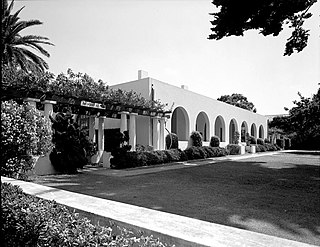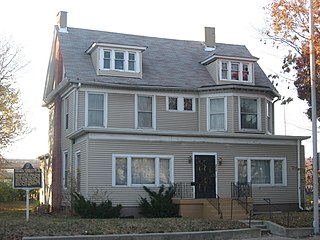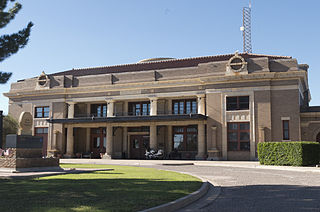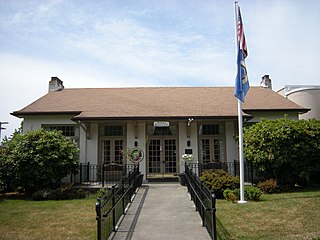
The Harmonie Club is a club located at 267 East Grand River Avenue in Downtown Detroit, Michigan. It was designated a Michigan State Historic Site in 1975 and listed on the National Register of Historic Places in 1980.

The Athenæum, originally named Das Deutsche Haus, is the most ornate and best-preserved building affiliated with the German American community of Indianapolis. Once used as a German American Turnverein and clubhouse, it currently houses many groups, organizations, and businesses. The Athenæum is located across Massachusetts Avenue from the Old National Centre. It was placed on the National Register of Historic Places on February 21, 1973. On October 31, 2016, it was named the 41st National Historic Landmark in Indiana.

Williston Congregational Church is a historic church in the center of Williston Village on United States Route 2 in Williston, Vermont. Built in 1832 and the interior restyled in 1860, this brick church is a fine local example of Gothic Revival architecture. It was listed on the National Register of Historic Places in 1973.

The Walter Merchant House, on Washington Avenue in Albany, New York, United States, is a brick-and-stone townhouse in the Italianate architectural style, with some Renaissance Revival elements. Built in the mid-19th century, it was listed on the National Register of Historic Places in 2002.

The Greenfield Union School is a school located at 420 West 7 Mile Road in Detroit, Michigan. A part of Detroit Public Schools (DPS), the school building was listed on the National Register of Historic Places in 2011.

The Wauwatosa Woman's Club Clubhouse is located in Wauwatosa, Wisconsin. It was added to the National Register of Historic Places in 1998.

The La Jolla Woman's Club is a women's club in a historic building in La Jolla, a neighborhood of San Diego, California. Designed and built by Irving Gill with assistance from his nephew Louis John Gill in 1914-1915, it is an important example of Gill's modern architectural style, and is listed on the National Register of Historic Places.

Sleepy Hollow Country Club is a historic country club in Scarborough-on-Hudson in Briarcliff Manor, New York. The club was founded in 1911, and its clubhouse was known as Woodlea, a 140-room Vanderbilt mansion owned by Colonel Elliott Fitch Shepard and his wife Margaret Louisa Vanderbilt Shepard. It was built in 1892–95 at a cost of $2 million and was designed by the architectural firm McKim, Mead & White; the estate became a contributing property to the Scarborough Historic District in 1984.

The Victoria Park Golf Clubhouse is a heritage-listed former club house at 309 Herston Road, Herston, City of Brisbane, Queensland, Australia. It was designed by Reyburn Jameson and built in 1931 and extended in 1939 and 1948. It is also known as the Pink Palace, after a nightclub which operated out of the building in the late 1970s and 1980s. The building now serves as offices for the Mental Illness Fellowship of Queensland. It was added to the Queensland Heritage Register on 17 December 1999.

Indiana State Federation of Colored Women's Clubs, also known as the Minor House, is a historic National Association of Colored Women's Clubs clubhouse in Indianapolis, Indiana. The two-and-one-half-story "T"-plan building was originally constructed in 1897 as a private dwelling for John and Sarah Minor; however, since 1927 it has served as the headquarters of the Indiana State Federation of Colored Women's Clubs, a nonprofit group of African American women. The Indiana federation was formally organized on April 27, 1904, in Indianapolis and incorporated in 1927. The group's Colonial Revival style frame building sits on a brick foundation and has a gable roof with hipped dormers. It was listed on the National Register of Historic Places in 1987.

The Spencer Hollow School is a historic school building at 50 Spencer Hollow Road in Springfield, Vermont. Built about 1810, it is a fine local example of a district schoolhouse. It was used as a school until 1926, and as a clubhouse for a time thereafter. It was listed on the National Register of Historic Places in 2012.

The Woman's Club of Evanston is a historic house in Evanston, Illinois and is the headquarters for the social club of the same name. It is located at 1702 Chicago Avenue. On November 9, 2006, the clubhouse was added to the National Register of Historic Places.

Tumut Post Office is a heritage-listed post office at 82–84 Wynyard Street, Tumut, New South Wales, Australia. It was added to the Australian Commonwealth Heritage List on 22 August 2012.

Temora Post Office is a heritage-listed post office at 173 Hoskins Street, Temora, New South Wales, Australia. It was added to the Australian Commonwealth Heritage List on 8 November 2011.

The Glendale Woman's Club was first organized in 1901 as a “Self Culture Club”, the primary aim of the Woman’s Club was self-improvement from a literary standpoint. They raised money for the first library and city parks. In 1898 the lumber company moved to a new two-story office building; Mr. Messenger could no longer manage the library. A library association was formed. The women’s club bought up stock and then assigned members to vote. Mrs. May Catlin Hanson, through club member Mrs. Lafe Myers, donated a building which was placed in park to house the library until a new one could be built. Mrs. Robert Clark and Mrs. J.M. (Mary) Pearson took the lead. Mary took a class on “Library work” in Phoenix to be able to “start it out right.”. By 1907, membership had increased to fifty members and it became impossible to continue meeting in homes, so the group began to think of acquiring its own clubhouse. On February 21, 1912, exactly 1 week after Arizona became the 48th state, the Club was recognized 501c3 non profit corporation with 85 members. The Glendale Woman's Club is a member of the General Federation of Women's Clubs.

The Woman's Club of Topeka was named as an entity in 1916 but has earlier roots. Its building, located just one-half block west of the Kansas State Capitol and completed in 1925, was listed on the National Register of Historic Places in 1982.

The El Paso and Southwestern Railroad Depot is a Beaux Arts building constructed in 1913 in Douglas, Arizona. Two-stories tall, it was a major station on the El Paso and Southwestern Railroad line. It is slightly to the northwest of the Douglas Historic District, sitting on a 3.2331 acre parcel. It's grounds include fountains and a period taxi stand.

The Kirkland Woman's Club is a women's club in Kirkland, Washington. Their clubhouse building was completed in 1925 and listed on the National Register of Historic Places in 1990.

The Fort Lauderdale Woman's Club is a women's club in downtown Fort Lauderdale, Florida. They completed their clubhouse building in 1917 which the National Register of Historic Places listed in 2019 as part of a Multiple Property Submission.





















